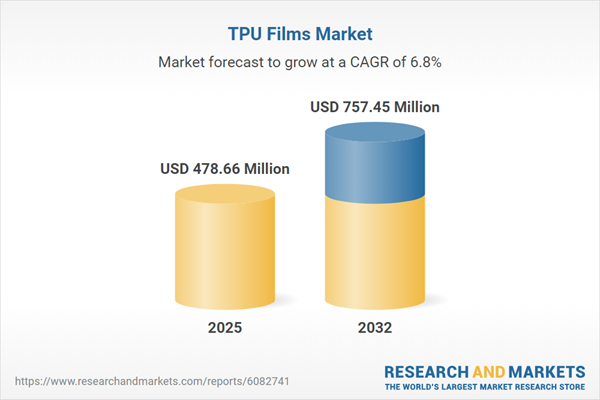Speak directly to the analyst to clarify any post sales queries you may have.
Thermoplastic polyurethane (TPU) films are recognized by senior industry leaders for their adaptability, durability, and the innovation they enable across high-performance manufacturing sectors. As demand accelerates, the TPU Films Market is shaped by urgent priorities in operational agility, regulatory compliance, and sustainability—making authoritative, data-backed insights indispensable for strategic planning.
Market Snapshot: TPU Films Market Size and Growth Outlook
The TPU Films Market is on a trajectory of strong and steady expansion, rising in value from USD 447.57 million in 2024 to USD 478.66 million in 2025, and expected to reach USD 757.45 million by 2032 at a compound annual growth rate (CAGR) of 6.79%. This upward trend is propelled by a broader adoption spectrum, with growth fueled by new end-use sectors, intensifying sustainability mandates, and greater manufacturing digitization. Enhanced awareness of segment-specific advantages and new applications positions the TPU Films Market as a focal point for innovation-driven procurement and investment strategies.
Scope & Segmentation of the TPU Films Market
- Product Types: Includes cast coated films prized for high surface quality, multilayer and single-layer cast films optimized by functional need, and extruded films, from monoextrusion for primary protective applications to coextrusion where a balance of strength and cost is required.
- Production Processes: Blown films offer multilayer or single-layer options to support uniformity and mechanical durability, while cast manufacturing encompasses processes such as compression casting for consistent thickness and slot die casting for precise dimensional control.
- Grades: Encompasses barrier types for critical protection, general-purpose films for versatile industrial uses, and specialty grades like conductive or flame-retardant varieties tailored to sensitive or regulated operational settings.
- End Use Industries: Markets driving demand span agriculture (as greenhouse and mulch films), construction and infrastructure (insulation, waterproofing), electronics (component packaging, circuit insulation), healthcare (medical device wraps, pharmaceutical packaging), and packaging for industrial, general, or medical applications.
- Applications: Key areas include agricultural productivity enhancements, graphic and display uses, overlamination, scratch or puncture protection, shrink and stretch wrap—each reflecting the adaptability and longevity found in advanced TPU film solutions.
- Regions Covered: The geographic analysis incorporates Americas, Europe, the Middle East and Africa, and Asia-Pacific, offering tailored perspectives on mature, transitioning, and rapidly growing industrial markets worldwide.
Key Takeaways for Decision-Makers in the TPU Films Market
- Emerging advances in polymer technologies, such as microcellular foaming and reactive extrusion, are enabling manufacturers to differentiate offerings and support customizable solutions for diverse end-user requirements.
- Market leaders are investing in sustainability initiatives by expanding use of bio-based inputs and closed-loop recycling, as well as anticipating compliance with tightening environmental standards shaping both procurement mandates and innovation direction.
- Changes in United States tariff policies are catalyzing realignments in the supplier base and production distribution, prompting use of logistics optimization and multisite manufacturing for greater flexibility and cost management.
- Smart segmentation strategies are facilitating targeted go-to-market initiatives, with segments such as graphic films expanding branding opportunities, and protective or specialty films responding to complex logistics and regulatory needs in electronics and healthcare supply chains.
- Regional market strategies now require dynamic adjustment: North America leverages established supply chains, EMEA focuses on eco-regulatory alignment, and Asia-Pacific capitalizes on industrial scaling and diversified consumer needs.
Tariff Impact: Navigating Trade Shifts in the TPU Films Market
Recent United States tariffs have introduced new challenges in global trade frameworks, motivating manufacturers to revisit logistics strategies, seek production within non-tariffed jurisdictions, and reinforce scenario planning. Multinational organizations and downstream users are adapting by optimizing procurement and fortifying supply resilience in response to rapidly shifting policy landscapes.
Methodology & Data Sources
This report leverages insights from direct interviews with senior executives, technical experts, and supply chain professionals across the TPU Films Market. Findings are verified using leading industry publications, official legal documentation, trade association datasets, and company financial reports. Quantitative methodologies include both top-down and bottom-up market modeling, scenario analysis for regulatory impacts, and cross-validation of results for robustness.
Why This Report Matters for B2B Leaders
- Empowers decision-makers with actionable insights to refine procurement, capacity planning, and technology allocation, enabling resilient and forward-looking strategies amid ongoing market and regulatory change.
- Presents detailed segmentation and regionally nuanced analysis, supporting precision in product development initiatives, targeted marketing, and optimized capital allocation across diverse application areas.
- Clarifies crucial sustainability drivers and evolving end-user expectations, equipping leadership teams with the knowledge required to ensure compliance and competitive positioning.
Conclusion
This report delivers comprehensive, actionable intelligence for senior stakeholders navigating the TPU Films Market. Use its strategic guidance to capitalize on new opportunities, manage emerging risks, and steer sustainable growth within high-performance industrial environments.
Table of Contents
3. Executive Summary
4. Market Overview
7. Cumulative Impact of Artificial Intelligence 2025
Companies Mentioned
The companies profiled in this TPU Films market report include:- Covestro AG
- BASF SE
- The Lubrizol Corporation
- Huntsman International LLC
- Wanhua Chemical Group Co. Ltd.
- Kaneka Corporation
- Mitsui Chemicals, Inc.
- COIM S.p.A.
- Emerald Performance Materials LP
- HEXPOL AB
Table Information
| Report Attribute | Details |
|---|---|
| No. of Pages | 180 |
| Published | November 2025 |
| Forecast Period | 2025 - 2032 |
| Estimated Market Value ( USD | $ 478.66 Million |
| Forecasted Market Value ( USD | $ 757.45 Million |
| Compound Annual Growth Rate | 6.7% |
| Regions Covered | Global |
| No. of Companies Mentioned | 11 |









